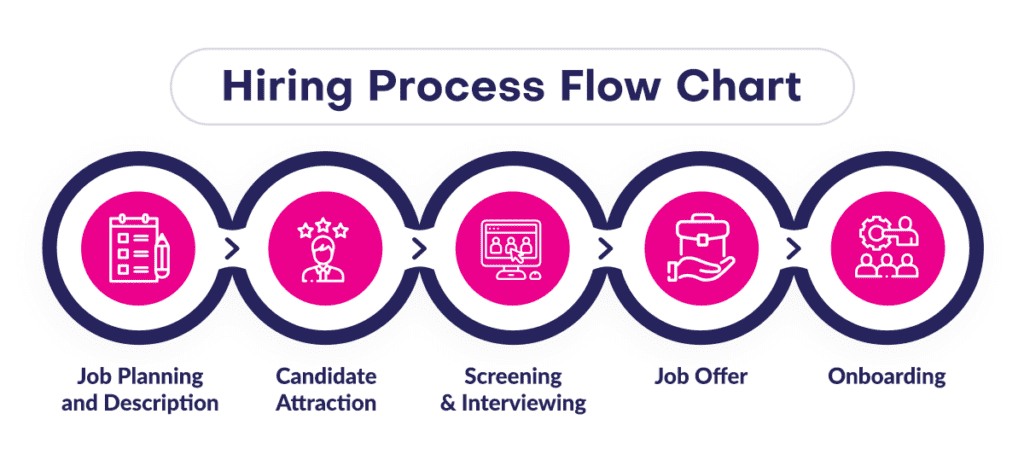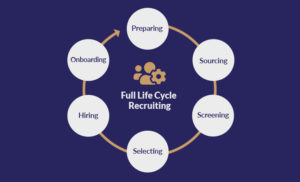Topics: Full Cycle Recruiting, full life cycle recruiting process, full recruiting life cycle, Hiring Process Flowcharts
How To Create a Hiring Process Flowchart in 2025
Posted on April 02, 2024
Written By QX Global Group

A hiring process flowchart serves as an essential tool for businesses and recruiters aiming to enhance their talent acquisition strategies. It operates as a visual guide, delineating the pathway companies follow to attract, evaluate, and onboard candidates who not only possess the requisite skills and experience but also embody the organisation’s core values and culture. Given the competitive nature of talent acquisition and the intricate steps involved, nearly 40% of HR leaders prioritise speeding up their hiring processes in their strategic planning. A well-constructed hiring process flowchart can significantly contribute to achieving this objective by offering clarity, consistency, and compliance throughout the recruitment journey.
This guide delves into the concept of a hiring process flowchart, its significance, and practical ways to leverage it for bolstering your organisation’s recruitment efforts.
Understanding the Hiring Process
The hiring process encompasses the actions undertaken by an organisation to identify, attract, and recruit skilled individuals for open roles, aiming to align candidates with the company’s mission and long-term objectives. This process is initiated when a vacancy arises and concludes with the successful onboarding of a new hire, predominantly managed by the HR department.
Defining a Hiring Process Flowchart
A hiring process flowchart, also known as a recruiting process flowchart, visually maps out the steps involved in attracting and recruiting suitable candidates. It incorporates various symbols and shapes to denote different stages and actions, facilitating a comprehensive overview of the recruitment cycle. This tool is invaluable for HR professionals to streamline recruitment, ensuring efficiency and compliance with legal standards.
The Benefits of a Hiring Process Flowchart
Utilising a hiring process flowchart offers multiple advantages:
- Enhanced Clarity: It provides a clear depiction of the recruitment process, outlining roles and responsibilities, thereby ensuring that all stakeholders are aligned and informed.
- Consistency and Compliance: It aids in maintaining a standardised approach to hiring, reducing the risk of oversight and ensuring adherence to legal and industry standards.
- Cost Efficiency: By optimising the recruitment workflow, it can lead to reduced hiring costs.
Steps in the Recruitment Process
The recruitment process typically unfolds through several key stages:
- Job Planning and Description: Collaborating with department heads to outline role requirements and craft detailed job descriptions.
- Candidate Attraction: Implementing strategies to attract suitable candidates through various sourcing channels.
- Screening and Interviewing: Conducting assessments and interviews to evaluate candidates’ suitability.
- Job Offer: Extending job offers to selected candidates and finalising employment contracts.
- Onboarding: Introducing the new employee to the organisation and ensuring a smooth integration into their role.
Types and Examples of Hiring Process Flowcharts
Several types of flowcharts can be employed, each with its specific utility:
- Linear Flowchart: Depicts the recruitment process in sequential order but may not capture repeated or circular tasks.
- Department-specific Flowchart: Shows parallel processes across different departments, useful for understanding interactions but can become complex.
- Parallel Flowchart: Breaks down tasks to allow simultaneous action, shortening the hiring timeline.
- Collaborative Flowchart: Highlights team involvement in hiring, promoting a unified approach but potentially blurring task ownership.
Implementing a Hiring Process Flowchart
When designing and using a hiring process flowchart, consider the following practices:
- Identify and segment key recruitment stages for clarity.
- Keep the flowchart straightforward to enhance comprehension.
- Standardise the process for consistency across all roles.
- Assign clear responsibilities and deadlines for each step.
- Utilise the flowchart as a training resource for HR and managerial staff.
- Ensure compatibility with recruitment software and systems.
- Employ the flowchart to monitor recruitment metrics for continuous improvement.
- Solicit feedback from all stakeholders to refine the process.
By tailoring the flowchart to your organisation’s unique needs and objectives, you can significantly improve your recruitment process, ultimately leading to the acquisition and retention of high-quality talent.
Originally published Apr 02, 2024 05:04:01, updated Mar 11 2025
Topics: Full Cycle Recruiting, full life cycle recruiting process, full recruiting life cycle, Hiring Process Flowcharts








